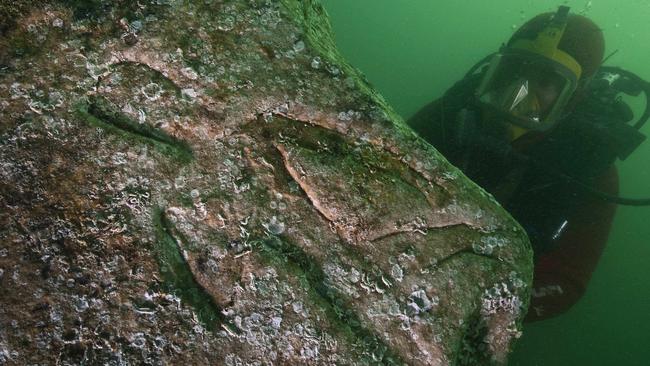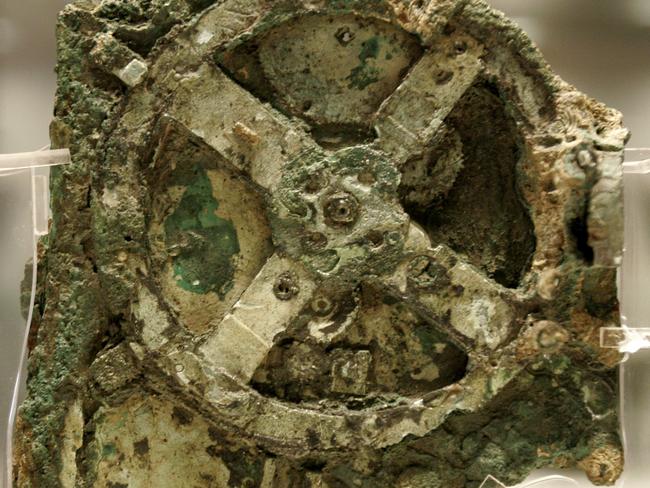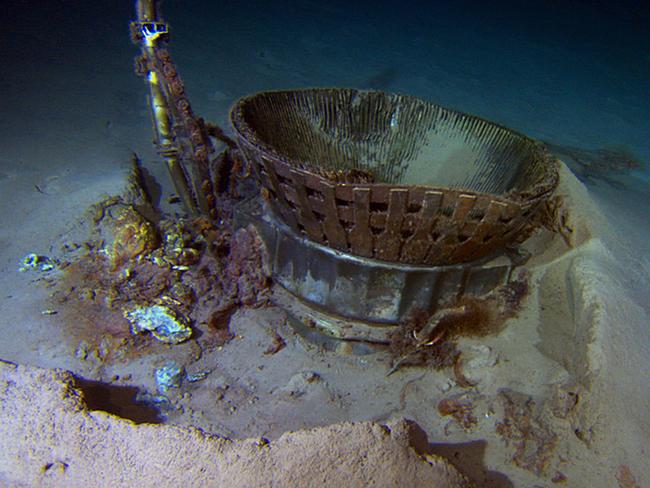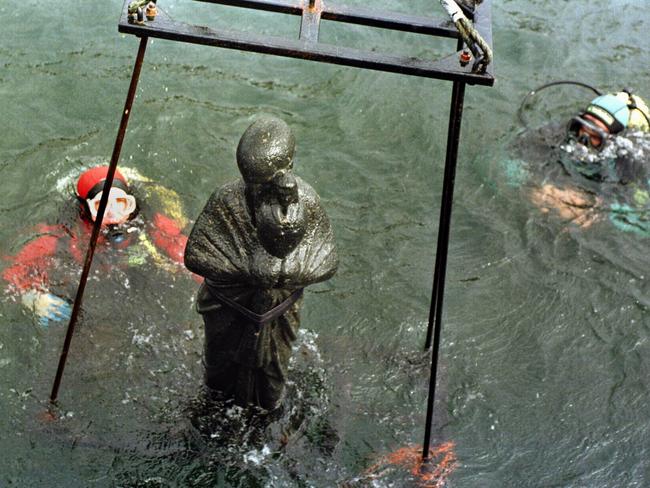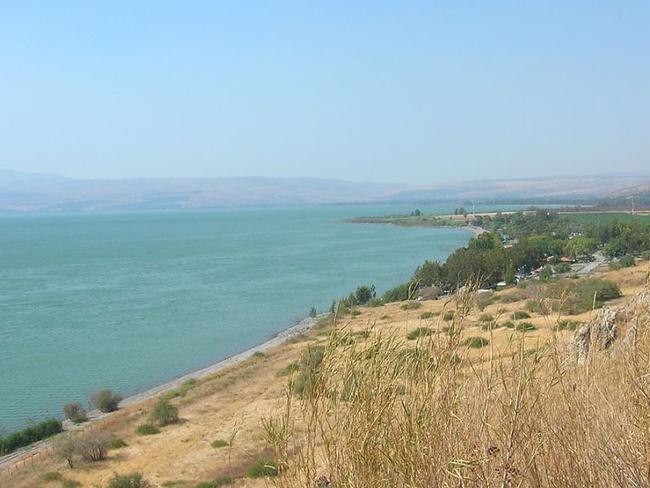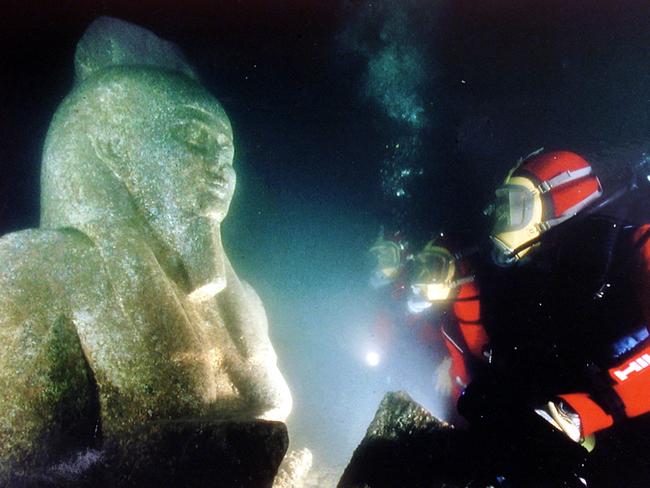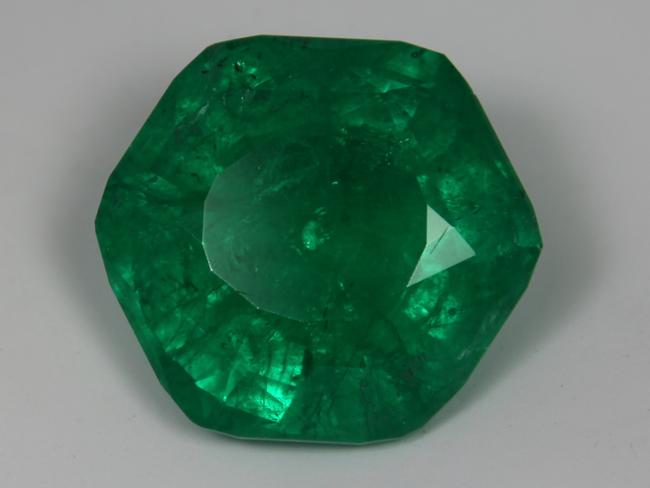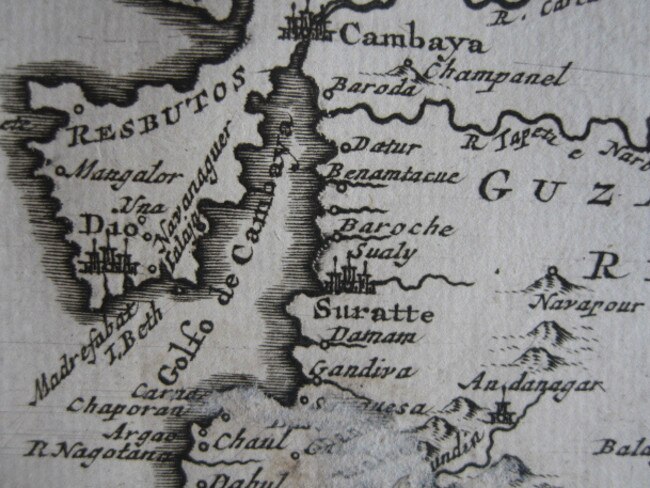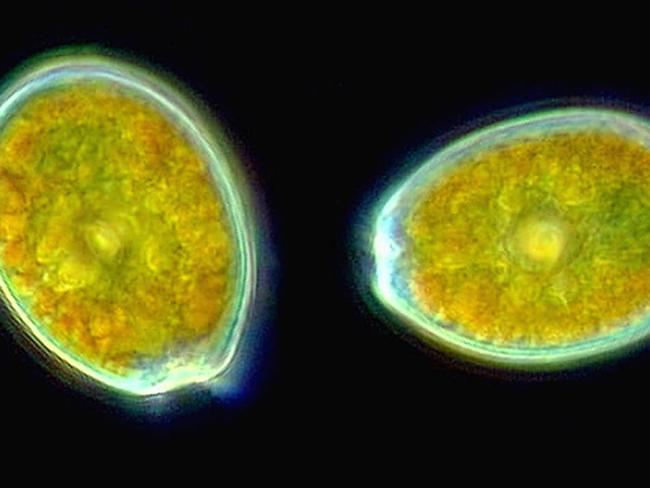Ten of the weirdest things found on the bottom of the ocean
FROM the first ever computer to Cleopatra’s lost city, these are some of the strangest things explorers have found at the bottom of the ocean.
3 min read
July 26, 2016 – 12:14PM
The Sun
A diver inspects a quartzite block with an engraving of a pharaoh, indicated by hieroglyphic inscriptions on the stone as Seti I, father of Ramses II, on the seabed of the harbour of Alexandria, Egypt, in 2010. It’s one of the more unusual finds in the depths of the ocean. Picture: Franck Goddio & Hilti Foundation, Christoph Gerigk/AP
More From Travel Updates
Striking reality of city inches from hell
Virgin’s shock flight cancellation move
Aussie’s miraculous chopper crash survival
EARTH is dominated by the oceans that cover 71 per cent of its surface but what lurks below all this water?
Experts estimate that we have explored less than five per cent of our underwater worlds leaving 95 per cent of untapped deep blue sea.
What riches could be buried beneath these tides? The Lost City of Atlantis? The remains of majestic sunken ships? At the very least we should expect to uncover a number of missing shopping trolleys.
As well as the many mysteries yet to be solved, exploration of the seas has led to the discovery some unexpected treasures, The Sun reports.
Here is a list of some of the weird, wonderful and even supernatural things recovered from our ocean beds.
1. THE ORIGINAL COMPUTER
A fragment of the 2100-year-old Antikythera Mechanism. Believed to be the earliest surviving mechanical computing device, it is a bronze system of cogs and wheels. Picture: Thanassis Stavrakis/AP
Discovered by sponge divers in the 1900s, this intriguing item was retrieved from the underwater wreckage of a ship in Greece.
Reported to have been built in the 2nd century, the Antikythera Mechanism has been dubbed “the first computer” as it is thought it was used to track the movements of the planets.
2. APOLLO 11 ENGINES
Image released by the Bezos Expeditions shows an F-1 thrust chamber from the Apollo 11 mission to the Moon. Picture: Bezos Expeditions/AFP
In 2013 components of two F-1 rocket engines from Apollo 11 were unearthed by none other than Amazon’s boss Jeff Bezos.
Part of the spaceships which had taken astronauts to the moon for the first time, they had been lying at the bottom of the ocean since 1969.
3. THE ‘NEW STONEHENGE’ IN THE BALTIC
The object bears a striking resemblance to Han Solo’s Millennium Falcon. Picture: YouTube
Spotted by a Swedish diving group, this unidentified object was discovered in 2012 laying at the bottom of the Baltic Sea.
The circular anomaly is yet to be identified, with its origins and functions unknown.
Some are calling it “the new Stonehenge”, while others have suggested the alien object could have come from outer space due to its likeness to Star Wars’ Millennium Falcon.
4. CLEOPATRA’S LOST CITY OF ALEXANDRIA
A 1.5m black granite statue of a priest dating to the 1st century is hoisted out of the sea off the Egyptian coast as researchers discover an ancient underwater city containing Cleopatra’s palace and relics.
Hidden for 1600 years, experts had all but given up on finding Cleopatra’s Alexandria until 1988 when archaeologists finally uncovered parts of the city.
In order to preserve the sphinxes and temples in their original positions Egypt is planning on building the world’s first underwater museum.
5. MYSTIFYING CIRCULAR STONE
The structure, weighing almost 60,000 tonnes, was found in the Sea of Galilee. Picture: Wikimedia Commons
In 2003 scientists discovered a round structure weighing nearly 60,000 tonnes in the Sea of Galilee.
The structure, made up of basalt rocks, is twice the size of Stonehenge and is like nothing else discovered on earth.
The object’s function and formation date are not known but archaeologists have suggested it could be an ancient communal burial site.
6. LOST ANCIENT CITY OF HERACLEION
An underwater archaeologist comes face to face with a large statue of the God Hapi — the god of flooding — discovered in front of the major dynastic temple dedicated to Khonsu-Herakles and part of the sunken city of Heracleion in Alexandria.
Another Egyptian wonder drowned beneath the Mediterranean, the city of Heracleion vanished 1200 years ago.
Around 46m underwater, archaeologists have discovered gold coins, five-metre statues and the remains of 64 ships in the submerged city.
Intriguingly, despite years of excavation and research scientists are yet to establish what caused it to sink in the first place.
7. DOOMED EMERALDS OF JAY MISCOVICH
Jay Miscovich became famous for discovering sunken treasure. Picture: AP
Amateur diver and treasure hunter Jay Miscovich stumbled across the find of his life when he discovered emeralds worth millions in the Gulf off Florida.
Rather than using the jewels to retire and spend the rest of his life buying happiness, Jay became tied up in a court battle where custody of the gems was contested.
Unable to sell the emeralds and reportedly with mounting debt, Jay committed suicide.
To this day it is not known where the stones came from.
8. INDIA’S SUNKEN CITY
The bay, now known as the Gulf of Khambhat, in a 1706 map. Picture: Wikimedia Commons
The submerged city in the Gulf of Cambay (Gulf of Khambhat), India, was discovered in 2002.
Dated at a whopping 9500 years old, the city suggests that life might be more ancient than some historians had previously thought.
Strangely, among the findings were intact human remains.
9. LIFE EXISTS AGAINST THE ODDS
Prorocentrum, an unusual dinoflagellate with two large valves, is often marked with pores which can be used in the identification of species. Picture: Bob Andersen and DJ Patterson, Census of Marine Life/AP
In the deepest depths of the oceans in the most inhabitable of environments, scientists have discovered living microbes.
The unlikely organisms have been dated back to the Jurassic period back when dinosaurs still roamed the earth.
These plucky microbes were found to have been alive for the past 86 million years despite having barely enough oxygen and no fresh food supply.
10. DEEP-SEA DIVING SPIDERS
The Diving Bell spider, or Water Spider, traps air in a dome-shaped web suspended between aquatic plants. How it appears to breathe underwater has been a focus of Australian researchers. Picture: Stefan Hetz
Incy wincy isn’t just lurking in the corners of your garden shed.
The eight legged creepy-crawlies can also be found swimming around underwater.
The Diving Bell spider can fill its sub-aqua webs with oxygen so it can live underwater, only coming up for air after many hours.
This article originally appeared on The Sun and was reproduced with permission.
News
The Hanging Temple: China’s 1,500-Year-Old Cliffside Marvel of Faith and Engineering
The Hanging Temple: China’s 1,500-Year-Old Cliffside Marvel of Faith and Engineering Perched precariously on the cliffs of Mount Heng in Shanxi Province, China, the Hanging Temple, also known as Xuankong Temple, Hengshan Hanging Temple, or Hanging Monastery, is an architectural…
The Willendorf Venus: A 30,000-Year-Old Masterpiece Reveals Astonishing Secrets
The Willendorf Venus: A 30,000-Year-Old Masterpiece Reveals Astonishing Secrets The “Willendorf Venus” stands as one of the most revered archaeological treasures from the Upper Paleolithic era. Discovered in 1908 by scientist Johann Veran near Willendorf, Austria, this small yet profound…
Unveiling the Maya: Hallucinogens and Rituals Beneath the Yucatán Ball Courts
Unveiling the Maya: Hallucinogens and Rituals Beneath the Yucatán Ball Courts New archaeological research has uncovered intriguing insights into the ritual practices of the ancient Maya civilization. The focus of this study is a ceremonial offering found beneath the sediment…
Uncovering the Oldest Agricultural Machine: The Threshing Sledge’s Neolithic Origins
Uncovering the Oldest Agricultural Machine: The Threshing Sledge’s Neolithic Origins The history of agricultural innovation is a fascinating journey that spans thousands of years, and one of the earliest known agricultural machines is the threshing sledge. Recently, a groundbreaking study…
Nara’s Ancient Sword: A 1,600-Year-Old Protector Against Evil Spirits
Nara’s Ancient Sword: A 1,600-Year-Old Protector Against Evil Spirits In a remarkable discovery that has captured the attention of archaeologists and historians alike, a 7.5-foot-long iron sword was unearthed from a 1,600-year-old burial mound in Nara, Japan. This oversized weapon,…
The Inflatable Plane, Dropped Behind the Lines for Downed Pilots
Experimental The Inflatable Plane, Dropped Behind the Lines for Downed Pilots The Inflatoplane from Goodyear was an unconventional aircraft developed by the Goodyear Aircraft Company, a branch of the renowned Goodyear Tire and Rubber Company, also famed for the Goodyear…
End of content
No more pages to load
